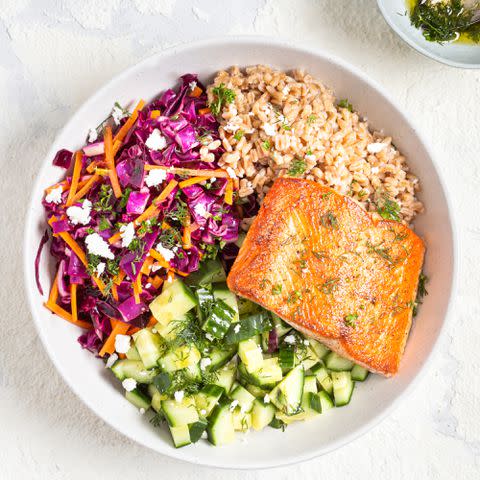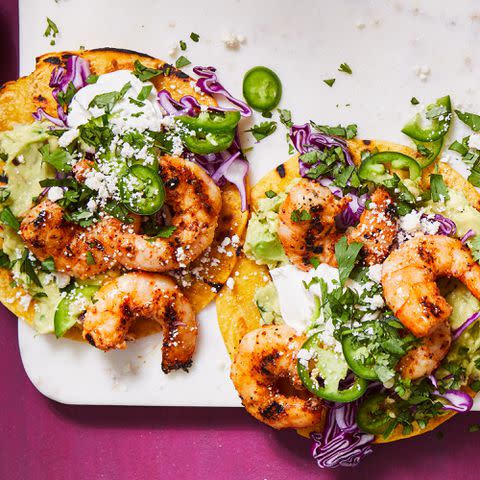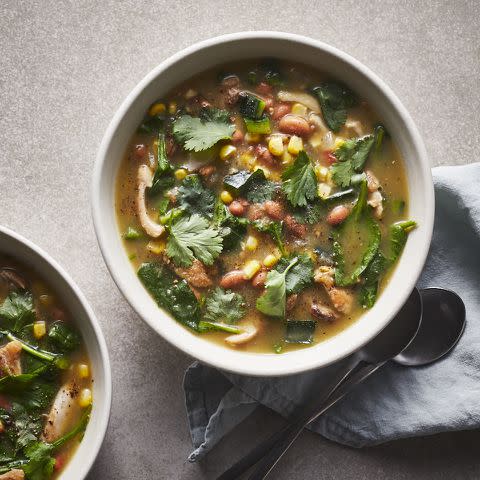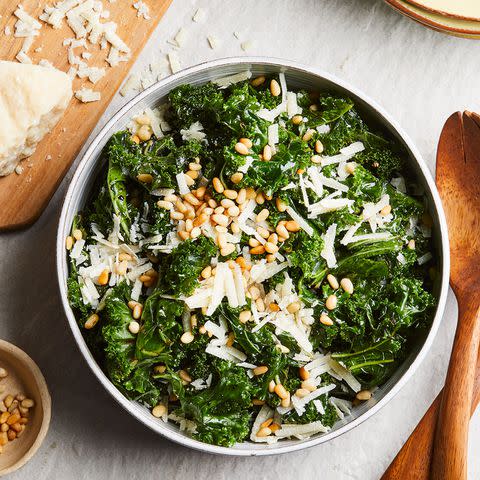7-Day High-Fiber Meal Plan for Insulin Resistance, Created by a Dietitian
Follow this plan for a week of high-fiber meals and snacks tailored to support healthy blood sugar levels.

Reviewed by Dietitian Jessica Ball, M.S., RD
Nearly 1 in 10 Americans have diabetes and more than 1 in 3 have prediabetes, according to the Centers for Disease Control and Prevention. Prediabetes is defined as a blood sugar level that is high but not quite high enough to be diagnosed with type 2 diabetes. Shockingly, nearly 80% of adults with prediabetes don’t know they have elevated blood sugar levels. With blood sugar disorders impacting so many Americans, it’s not surprising that many of us are turning our attention to insulin resistance and how to improve blood sugar levels.
Insulin is a hormone released by the pancreas in response to a normal increase in blood sugar when the carbohydrates we eat are broken down into the simplest form of sugar called glucose. When everything is working well, insulin moves glucose out of the blood and into our cells and muscles to be used or stored for energy. Per the National Institute of Diabetes and Digestive and Kidney Diseases, when insulin resistance develops, the body doesn’t respond as effectively, which requires more and more insulin to be released to help move glucose from the blood to cells. Eventually, the body can’t keep up with the increased insulin needs, resulting in elevated blood sugar and often consequently, prediabetes or type 2 diabetes.
In this seven-day meal plan, we focus on fiber, which we named The #1 Nutrient to Lower Blood Sugar Levels. Each day provides at least 35 grams of fiber (and 76 grams of satiating protein) to support stable blood sugars and a steady insulin response. In addition to incorporating more exercise, the NIDDK recommends weight loss as another strategy to improve blood sugars. To promote a healthy weight loss for most people, we set this plan at 1,500 calories per day. For those with other calorie needs, we also included modifications for 1,200 and 2,000 calories a day. This meal plan is meant to serve as a framework for a high-fiber healthy eating plan. It does not need to be followed exactly to reap the benefits—listen to your hunger cues and opt to make swaps as needed!
Learn More: Walking After Meals for Just 2 Minutes Is Enough to Lower Blood Sugar—Here's Why, According to Science
Does Fiber Help with Insulin Resistance?
So, how do we promote healthy blood sugar levels and lower the risk of developing insulin resistance? Eating more fiber can help. Fiber is the unassuming workhorse of the nutrition world. Its health benefits are numerous—fiber is linked to improved heart health, better digestion and, of course, healthier blood sugar levels and a reduced risk of developing type 2 diabetes.
A 2018 research study published in the journal Nutrients found that as fiber intake increased, insulin resistance decreased. Plus, eating more fiber can help promote weight loss, even when no other diet changes occur. Because fiber can independently improve insulin resistance plus support weight loss—which also can help improve insulin resistance—it’s a helpful nutrient to focus on if you’re trying to improve your blood sugar levels.
Though both soluble and insoluble fiber have their benefits and should be included in a healthy eating plan, insoluble fiber seems to be particularly beneficial in promoting healthy blood sugar levels. In fact, 2018 research published in The Journal of Nutrition found that a diet high in insoluble fiber may significantly reduce the risk of developing type 2 diabetes. Sources of insoluble fiber include bran, whole wheat, barley, oats, nuts and the skin of many fruits and vegetables.
High-Fiber Foods to Focus On:
Whole grains: Oats, bulgur, quinoa, whole-wheat products, brown rice, farro, teff, sorghum, buckwheat
Legumes: Beans, lentils, edamame
Fruit: Especially raspberries, blueberries, blackberries, pear, apple, fig, avocado, kiwi
Vegetables: Especially artichoke, sweet potato, green peas, Brussels sprouts, kale, collards, beets, carrots, broccoli, cauliflower
Nuts and seeds, including flax, chia and pumpkin seeds
How to Meal-Prep Your Week of Meals:
Make Zucchini Noodles with Quick Turkey Bolognese to have for lunch on Days 2 through 5.
Prepare Maple Granola to have with breakfast throughout the week.
Make Muffin-Tin Omelets with Bell Pepper, Black Beans & Jack Cheese to have as breakfast throughout the week.

Day 1
Breakfast (338 calories)
1 serving Muffin-Tin Omelets with Bell Pepper, Black Beans & Jack Cheese
1 cup blackberries
1 cup low-fat plain kefir
A.M. Snack (131 calories)
1 large pear
Lunch (360 calories)
1 serving White Bean & Veggie Salad
P.M. Snack (95 calories)
1 medium apple
Dinner (572 calories)
1 serving Salmon Power Bowl
Daily Totals: 1,497 calories, 65g fat, 76g protein, 166g carbohydrate, 38g fiber, 1,259mg sodium
Make it 1,200 calories: Omit kefir at breakfast, change P.M. snack to 1 medium orange and change dinner to 1 serving Sheet-Pan Roasted Salmon & Vegetables.
Make it 2,000 calories: Add ¼ cup unsalted dry-roasted almonds to A.M. snack, add ½ cup low-fat plain strained yogurt (such as Greek-style) to lunch, and add 2 Tbsp. almond butter to P.M. snack.

Day 2
Breakfast (345 calories)
1 cup low-fat plain strained yogurt, such as Greek-style
1 serving Maple Granola
½ cup raspberries (or fruit of choice)
A.M. Snack (150 calories)
¾ cup edamame, in pods
Lunch (357 calories)
1 medium bell pepper, sliced
¼ cup hummus
P.M. Snack (175 calories)
¼ cup unsalted dry-roasted shelled pistachios
Dinner (499 calories)
Daily Totals: 1,525 calories, 65g fat, 116g protein, 132g carbohydrate, 35g fiber, 1,806mg sodium
Make it 1,200 calories: Change A.M. snack to 1 clementine, omit hummus at lunch, and change P.M. snack to ⅔ cup blueberries.
Make it 2,000 calories: Increase to 1 cup edamame, in pods, at A.M. snack, add 1 clementine to P.M. snack, add 1 serving Massaged Kale Salad to dinner, and add 1 serving Apple with Cinnamon Almond Butter as an evening snack.

Day 3
Breakfast (345 calories)
1 cup low-fat plain strained yogurt, such as Greek-style
1 serving Maple Granola
½ cup raspberries (or fruit of choice)
A.M. Snack (131 calories)
1 large pear
Lunch (357 calories)
1 medium bell pepper, sliced
¼ cup hummus
P.M. Snack (238 calories)
¼ cup unsalted dry-roasted shelled pistachios
1 cup blackberries
Dinner (432 calories)
1 serving Sesame Kohlrabi & Chicken Salad
Daily Totals: 1,503 calories, 66g fat, 99g protein, 145g carbohydrate, 37g fiber, 1,674mg sodium
Make it 1,200 calories: Change A.M. snack to 1 clementine and change P.M. snack to ¾ cup blackberries.
Make it 2,000 calories: Add 1 serving Sprouted-Grain Toast with Peanut Butter & Banana to breakfast and add ¼ cup unsalted dry-roasted almonds to A.M. snack.

Day 4
Breakfast (338 calories)
1 serving Muffin-Tin Omelets with Bell Pepper, Black Beans & Jack Cheese
1 cup blackberries
1 cup low-fat plain kefir
A.M. Snack (193 calories)
1 medium apple
1 Tbsp. almond butter
Lunch (357 calories)
1 medium bell pepper, sliced
¼ cup hummus
P.M. Snack (176 calories)
¼ cup unsalted dry-roasted shelled pistachios
Dinner (448 calories)
1 serving Grilled Shrimp Tostadas
1 serving Bang Bang Cabbage Slaw
Daily Totals: 1,512 calories, 74g fat, 89g protein, 141g carbohydrate, 35g fiber, 2,263mg sodium
Make it 1,200 calories: Change A.M. snack to 1 medium orange and change P.M. snack to ¼ cup raspberries.
Make it 2,000 calories: Increase to 2 Tbsp. almond butter at A.M. snack, add 1 large pear to P.M. snack, and add 1 oz. dark chocolate with 10 unsalted dry-roasted almonds as an evening snack.

Day 5
Breakfast (345 calories)
1 cup low-fat plain strained yogurt, such as Greek-style
1 serving Maple Granola
½ cup raspberries (or fruit of choice)
A.M. Snack (131 calories)
1 large pear
Lunch (357 calories)
1 medium bell pepper, sliced
¼ cup hummus
P.M. Snack (242 calories)
1 medium apple
1½ Tbsp. almond butter
Dinner (404 calories)
1 serving Chicken Chili Verde
Meal-Prep Tip: Reserve 2 servings Chicken Chili Verde to have for lunch on Days 6 and 7.
Daily Totals: 1,479 calories, 57g fat, 88g protein, 172g carbohydrate, 35g fiber, 1,549mg sodium
Make it 1,200 calories: Change A.M. snack to ¼ cup blueberries and omit almond butter at P.M. snack.
Make it 2,000 calories: Increase to 2 Tbsp. almond butter at P.M. snack, add 1 serving Guacamole Chopped Salad to dinner, and add 1 oz. dark chocolate with 10 unsalted dry-roasted almonds as an evening snack.

Day 6
Breakfast (345 calories)
1 cup low-fat plain strained yogurt, such as Greek-style
1 serving Maple Granola
½ cup raspberries (or fruit of choice)
A.M. Snack (62 calories)
1 cup blackberries
Lunch (408 calories)
1 serving Chicken Chili Verde
P.M. Snack (209 calories)
1 large pear
1 large hard-boiled egg
Dinner (499 calories)
1 serving Kale Salad with Balsamic & Parmesan
Daily Totals: 1,523 calories, 67g fat, 78g protein, 161g carbohydrate, 38g fiber, 1,346mg sodium
Make it 1,200 calories: Change P.M. snack to 1 clementine and omit Kale Salad with Balsamic & Parmesan at dinner.
Make it 2,000 calories: Add 1 serving Sprouted-Grain Toast with Peanut Butter & Banana to breakfast and ¼ cup unsalted dry-roasted shelled pistachios to A.M. snack.

Day 7
Breakfast (338 calories)
1 serving Muffin-Tin Omelets with Bell Pepper, Black Beans & Jack Cheese
1 cup blackberries
1 cup low-fat plain kefir
A.M. Snack (95 calories)
1 medium apple
Lunch (404 calories)
1 serving Chicken Chili Verde
P.M. Snack (214 calories)
1 large pear
½ cup low-fat plain strained yogurt, such as Greek-style
Dinner (467 calories)
1 serving Chili-Rubbed Flank Steak Salad
Daily Totals: 1,518 calories, 51g fat, 104g protein, 172g carbohydrate, 35g fiber, 1,616mg sodium
Make it 1,200 calories: Omit kefir at breakfast and change P.M. snack to ½ cup sliced strawberries.
Make it 2,000 calories: Add 2 Tbsp. almond butter to A.M. snack and add 1 oz. dark chocolate with 14 unsalted dry-roasted almonds as an evening snack.
Read the original article on Eating Well.

